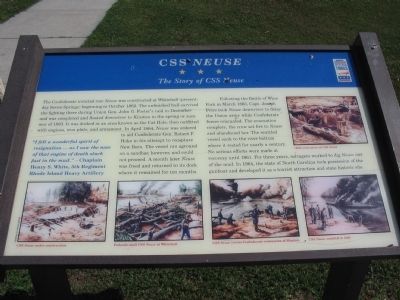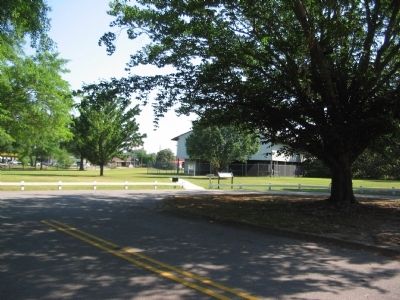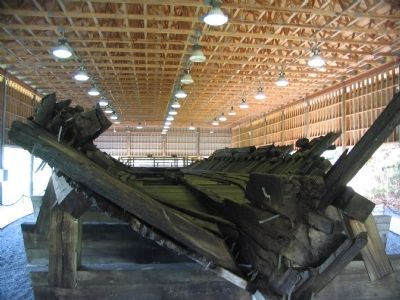Kinston in Lenoir County, North Carolina — The American South (South Atlantic)
CSS Neuse
The Story of CSS Neuse
Following the Battle of Wyse Fork in March 1865, Capt. Joseph Price took Neuse downriver to delay the Union army while Confederate forces evacuated. The evacuation complete, the crew set fire to Neuse and abandoned her. The scuttled vessel sank to the river bottom where it rested for nearly a century. No serious efforts were made at recovery until 1961. For three years, salvagers worked to dig Neuse out of the mud. In 1964, the state of North Carolina took possession of the gunboat and developed it as a tourist attraction and state historic site.
"I felt a wonderful spirit of resignation... as I saw the nose of that engine of death stuck fast in the mud." - Chaplain Henry S. White, 5th Regiment Rhode Island Heavy Artillery
Erected by North Carolina Civil War Trails.
Topics and series. This historical marker is listed in these topic lists: War, US Civil • Waterways & Vessels. In addition, it is included in the North Carolina Civil War Trails series list. A significant historical month for this entry is March 1865.
Location. Marker has been reported permanently removed. It was located near 35° 16.015′ N, 77° 37.28′ W. Marker was in Kinston, North Carolina, in Lenoir County. Marker was at the intersection of Richard Caswell Grave Road and West Vernon Avenue (U.S. 70/258), on the right when traveling east on Richard Caswell Grave Road. Located in the CSS Neuse and Caswell State Historic Site. Touch for map. Marker was in this post office area: Kinston NC 28504, United States of America.
We have been informed that this sign or monument is no longer there and will not be replaced. This page is an archival view of what was.
Other nearby markers. At least 8 other markers are within 3 miles of this location, measured as the crow flies. Moving the CSS Neuse (within shouting distance of this marker); Grave of Richard Caswell (about 600 feet away, measured in a direct line); Richard Caswell (about 600 feet away); Walk of Honor Memorial (approx. 2.2 miles away); Cat Hole (approx. 2.2 miles away); CSS Neuse Confederate Ironclad Gunboat (approx. 2.2 miles away); Birth of Funk (approx. 2.3 miles away); Kinston Sit-Ins (approx. 2.3 miles away). Touch for a list and map of all markers in Kinston.
More about this marker. Across the bottom of the marker are artist impressions of the career of the Neuse - CSS Neuse under construction, Federal shell CSS Neuse at Whitehall, CSS Neuse covers Confederate evacuation at Kinston, and CSS Neuse scuttled in 1865. In the upper right is a photo of 1960s excavation of the CSS Neuse.
Additional keywords. CSS Neuse
Credits. This page was last revised on August 1, 2020. It was originally submitted on May 8, 2010. This page has been viewed 1,115 times since then and 26 times this year. Last updated on July 27, 2020, by Andrew Duppstadt of Kinston, North Carolina. Photos: 1, 2, 3. submitted on May 8, 2010, by Craig Swain of Leesburg, Virginia. • J. Makali Bruton was the editor who published this page.


